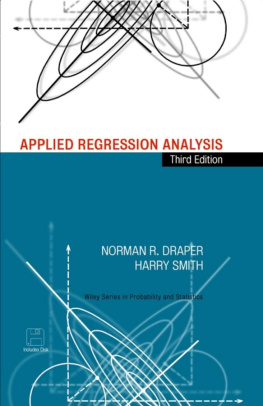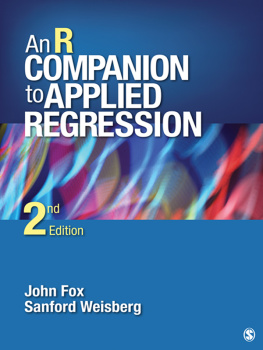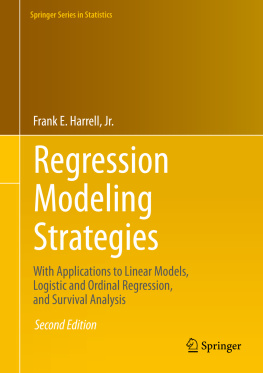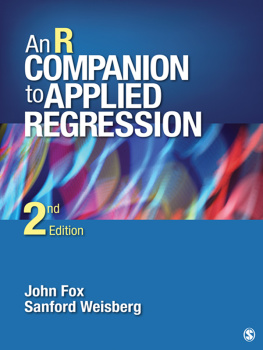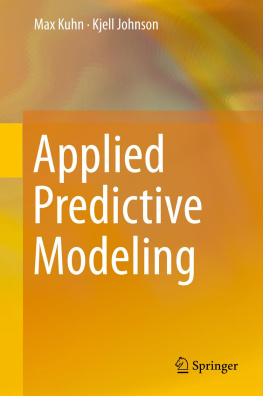Pardoe Iain - Applied Regression Modeling
Here you can read online Pardoe Iain - Applied Regression Modeling full text of the book (entire story) in english for free. Download pdf and epub, get meaning, cover and reviews about this ebook. year: 2020, genre: Children. Description of the work, (preface) as well as reviews are available. Best literature library LitArk.com created for fans of good reading and offers a wide selection of genres:
Romance novel
Science fiction
Adventure
Detective
Science
History
Home and family
Prose
Art
Politics
Computer
Non-fiction
Religion
Business
Children
Humor
Choose a favorite category and find really read worthwhile books. Enjoy immersion in the world of imagination, feel the emotions of the characters or learn something new for yourself, make an fascinating discovery.

- Book:Applied Regression Modeling
- Author:
- Genre:
- Year:2020
- Rating:3 / 5
- Favourites:Add to favourites
- Your mark:
- 60
- 1
- 2
- 3
- 4
- 5
Applied Regression Modeling: summary, description and annotation
We offer to read an annotation, description, summary or preface (depends on what the author of the book "Applied Regression Modeling" wrote himself). If you haven't found the necessary information about the book — write in the comments, we will try to find it.
Applied Regression Modeling — read online for free the complete book (whole text) full work
Below is the text of the book, divided by pages. System saving the place of the last page read, allows you to conveniently read the book "Applied Regression Modeling" online for free, without having to search again every time where you left off. Put a bookmark, and you can go to the page where you finished reading at any time.
Font size:
Interval:
Bookmark:
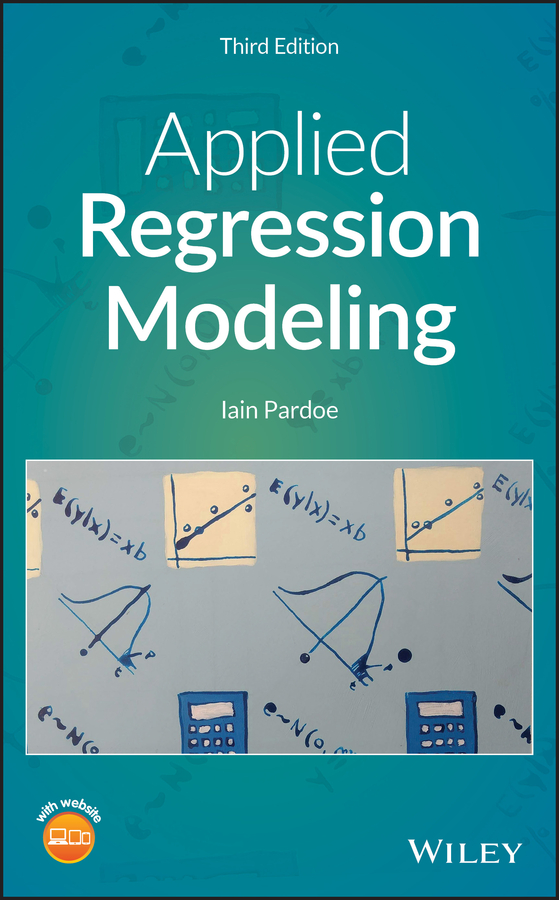
- Chapter 3
- Chapter 4
- Chapter 5
- Chapter 1
- Chapter 2
- Chapter 3
- Chapter 4
- Chapter 5
Third Edition
Iain Pardoe
Thompson Rivers University
The Pennsylvania State University

Copyright
This edition first published 2021
2021 John Wiley & Sons, Inc
Edition History
Second Edition, 2012, John Wiley & Sons, Inc
All rights reserved. No part of this publication may be reproduced, stored in a retrieval system, or transmitted, in any form or by any means, electronic, mechanical, photocopying, recording or otherwise, except as permitted by law. Advice on how to obtain permission to reuse material from this title is available at http://www.wiley.com/go/permissions.
The right of Iain Pardoe to be identified as the author of this work has been asserted in accordance with law.
Registered Office
John Wiley & Sons, Inc., 111 River Street, Hoboken, NJ 07030, USA
Editorial Office
111 River Street, Hoboken, NJ 07030, USA
For details of our global editorial offices, customer services, and more information about Wiley products visit us at www.wiley.com.
Wiley also publishes its books in a variety of electronic formats and by printondemand. Some content that appears in standard print versions of this book may not be available in other formats.
Limit of Liability/Disclaimer of Warranty
While the publisher and authors have used their best efforts in preparing this work, they make no representations or warranties with respect to the accuracy or completeness of the contents of this work and specifically disclaim all warranties, including without limitation any implied warranties of merchantability or fitness for a particular purpose. No warranty may be created or extended by sales representatives, written sales materials or promotional statements for this work. The fact that an organization, website, or product is referred to in this work as a citation and/or potential source of further information does not mean that the publisher and authors endorse the information or services the organization, website, or product may provide or recommendations it may make. This work is sold with the understanding that the publisher is not engaged in rendering professional services. The advice and strategies contained herein may not be suitable for your situation. You should consult with a specialist where appropriate. Further, readers should be aware that websites listed in this work may have changed or disappeared between when this work was written and when it is read. Neither the publisher nor authors shall be liable for any loss of profit or any other commercial damages, including but not limited to special, incidental, consequential, or other damages.
Library of Congress CataloginginPublication Data
Names: Pardoe, Iain, 1970- author
Title: Applied regression modeling / Iain Pardoe, Thompson Rivers
University, The Pennsylvania State University.
Description: Third edition. | Hoboken, New Jersey : Wiley, [2020] |
includes bibliographical references and index.
Identifiers: LCCN 2020028117 (print) | LCCN 2020028118 (ebook) | ISBN
9781119615866 (cloth) | ISBN 9781119615880 (adobe pdf) | ISBN
9781119615903 (epub)
Subjects: LCSH: Regression analysis. | Statistics.
Classification: LCC QA278.2 .P363 2020 (print) | LCC QA278.2 (ebook) |
DDC 519.5/36dc23
LC record available at https://lccn.loc.gov/2020028117
LC ebook record available at https://lccn.loc.gov/2020028118
Cover Design: Wiley
Cover Image: Courtesy of Bethany Pardoe
To Bethany and Sierra
The first edition of this book was developed from class notes written for an applied regression course taken primarily by undergraduate business majors in their junior year at the University of Oregon. Since the regression methods and techniques covered in the book have broad application in many fields, not just business, the second edition widened its scope to reflect this. This third edition refines and improves the text further. Details of the major changes for the third edition are included at the end of this preface.
The book is suitable for any undergraduate or graduate statistics course in which regression analysis is the main focus. A recommended prerequisite is an introductory probability and statistics course. It is also appropriate for use in an applied regression course for MBAs and for vocational, professional, or other nondegree courses. Mathematical details have deliberately been kept to a minimum, and the book does not contain any calculus. Instead, emphasis is placed on applying regression analysis to data using statistical software, and understanding and interpreting results. Optional formulas are provided for those wishing to see these details and the book now includes an informal overview of matrices in the context of multiple linear regression.
), a table of critical values for the tdistribution, notation and formulas used throughout the book, a glossary of important terms, a short mathematics refresher, a tutorial on multiple linear regression using matrices, and brief answers to selected homework problems.
The first five chapters of the book have been used successfully in quarterlength courses at a number of institutions. An alternative approach for a quarterlength course would be to skip some of the material in Chapters 4 and 5 and substitute one or more of the case studies in Chapter 6 (www.wiley.com/go/pardoe/AppliedRegressionModeling3e), or briefly introduce some of the topics in Chapter 7 (www.wiley.com/go/pardoe/AppliedRegressionModeling3e). A semesterlength course could comfortably cover all the material in the book.
The website for the book, which can be found at www.wiley.com/go/pardoe/Applied RegressionModeling3e, contains supplementary material designed to help both the instructor teaching from this book and the student learning from it. There you'll find all the datasets used for examples and homework problems in formats suitable for most statistical software packages, as well as detailed instructions for using the major packages, including SPSS, Minitab, SAS, JMP, Data Desk, EViews, Stata, Statistica, R, and Python. There is also some information on using the Microsoft Excel spreadsheet package for some of the analyses covered in the book (dedicated statistical software is necessary to carry out all of the analyses). The website also includes information on obtaining a instructor's manual containing complete answers to all the homework problems, as well as instructional videos, practice quizzes, and further ideas for organizing class time around the material in the book.
The book contains the following stylistic conventions:
- When displaying calculated values, the general approach is to be as accurate as possible when it matters (such as in intermediate calculations for problems with many steps), but to round appropriately when convenient or when reporting final results for realworld questions. Displayed results from statistical software use the default rounding employed in R throughout.
- In the author's experience, many students find some traditional approaches to notation and terminology a barrier to learning and understanding. Thus, some traditions have been altered to improve ease of understanding. These include: using familiar Roman letters in place of unfamiliar Greek letters (e.g.,

Font size:
Interval:
Bookmark:
Similar books «Applied Regression Modeling»
Look at similar books to Applied Regression Modeling. We have selected literature similar in name and meaning in the hope of providing readers with more options to find new, interesting, not yet read works.
Discussion, reviews of the book Applied Regression Modeling and just readers' own opinions. Leave your comments, write what you think about the work, its meaning or the main characters. Specify what exactly you liked and what you didn't like, and why you think so.



